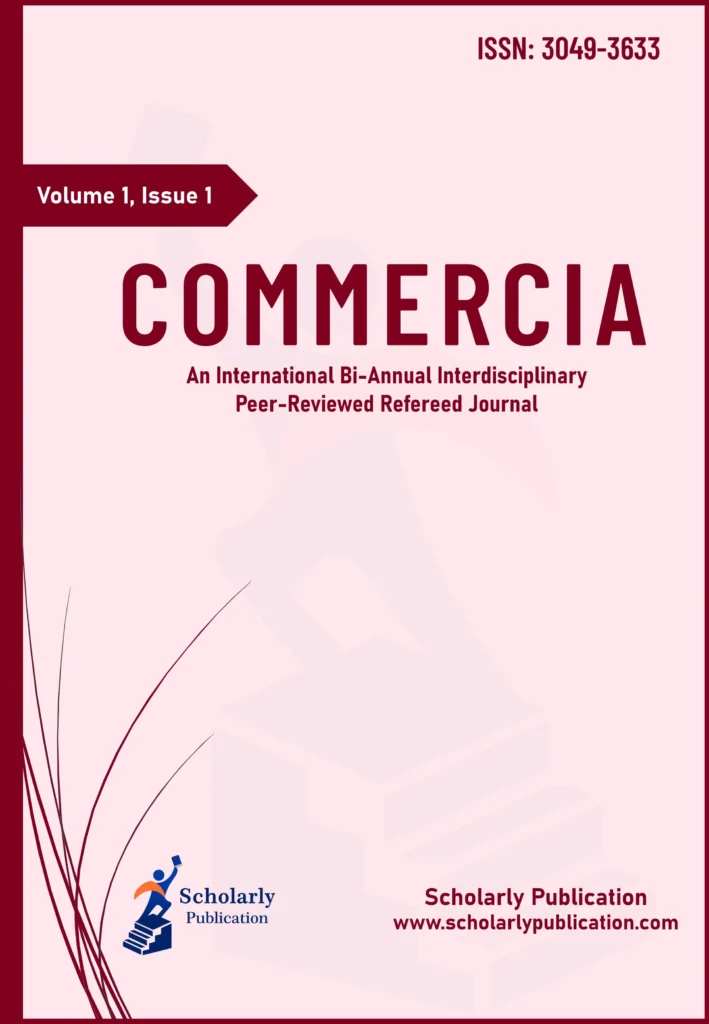Linking Performance Evaluation Techniques with Employee Engagement
Volume 1, Issue 1, Article Number: 251009 (2025)
Home >> Commercia >> Volume 1, Issue 1
Mohammad Shakeel Akhtar1,* | Dr. Vimlesh Tanwar2 | Dr. Nishtha Pareek3
1Research Scholar, Department of Commerce and Management, Banasthali Vidyapith, Tonk 304022, Rajasthan, India
2Assistant Professor, Department of Commerce and Management, Banasthali Vidyapith, Tonk 304022, Rajasthan, India
3Associate Professor, Department of Commerce and Management, Banasthali Vidyapith, Tonk 304022, Rajasthan, India
*Corresponding Author: md.shakeel.akhtar@gmail.com
Received: 12 May 2025 | Revised: 19 May 2025
Accepted: 20 May 2025 | Published Online: 24 May 2025
DOI: https://doi.org/10.5281/zenodo.15501031
© 2025 The Authors, under a Creative Commons license, Published by Scholarly Publication
Abstract
This paper assesses the role of different organizational performance appraisal techniques in reference to employee engagement in contemporary firms. The research intends to analyze the motivational impacts of directed performance evaluations, like 360-degree feedback and continuous monitoring on commitment from the employees. The study employs qualitative methods through literature and theoretical analysis, drawing on the JD-R model alongside Self-Determination Theory and Organizational Justice Theory. Results indicate that active participation and provision of feedback within performance systems markedly increase engagement, whereas punitive evaluations without constructive feedback led to disengagement and attrition. The paper revolves around the developmental evaluation approach and the culture of engagement within the organization.
Keywords
Employee Engagement, Performance Evaluation, 360-Degree Feedback, Management by Objectives (MBO), Organizational Justice, Continuous Feedback, Leadership Style, Human Resource Management
References
Aguinis, H. (2023). Performance management. Sage Publications.
Ahsan, M. J. (2025). Cultivating a culture of learning: the role of leadership in fostering lifelong development. The learning organization, 32, 282-306.
[View Article] [Google Scholar]
Anseel, F., Beatty, A. S., Shen, W., Lievens, F., & Sackett, P. R. (2015). How are we doing after 30 years? A meta-analytic review of the antecedents and outcomes of feedback-seeking behavior. Journal of Management, 41, 318-348.
[View Article] [Google Scholar]
Bakker, A. B., & Albrecht, S. (2018). Work engagement: current trends. Career development international, 23, 4-11.
[View Article] [Google Scholar]
Bakker, A. B., & Demerouti, E. (2007). The job demands‐resources model: State of the art. Journal of managerial psychology, 22, 309-328.
[View Article] [Google Scholar]
Bandura, A. (1997). Self-Efficacy: The Exercise of Control. Macmillan.
Bass, B. M., & Avolio, B. J. (1994). Improving Organizational Effectiveness Through Transformational Leadership. SAGE Publications.
Blau, P. (2017). Exchange and power in social life. Routledge.
Breevaart, K., Bakker, A., Hetland, J., Demerouti, E., Olsen, O. K., & Espevik, R. (2014). Daily transactional and transformational leadership and daily employee engagement. Journal of occupational and organizational psychology, 87, 138-157.
[View Article] [Google Scholar]
Buckingham, M., & Goodall, A. (2015). Reinventing performance management. Harvard Business Review, 93, 40-50.
Cardy, R. L., & Dobbins, G. H. (1994). Performance Appraisal: Alternative Perspectives. South-Western Publishing.
Colquitt, J. A., Conlon, D. E., Wesson, M. J., Porter, C. O., & Ng, K. Y. (2001). Justice at the millennium: a meta-analytic review of 25 years of organizational justice research. Journal of applied psychology, 86, 425.
[View Article] [Google Scholar]
Cropanzano, R., & Wright, T. A. (2001). When a” happy” worker is really a” productive” worker: A review and further refinement of the happy-productive worker thesis. Consulting Psychology Journal: Practice and Research, 53, 182.
[View Article] [Google Scholar]
Deci, E. L., & Ryan, R. M. (2012). Self-determination theory. Handbook of theories of social psychology, 1, 416-436.
[View Article] [Google Scholar]
Deloitte (2015). Performance Management: The secret ingredient.
Dirks, K. T., & Ferrin, D. L. (2002). Trust in leadership: meta-analytic findings and implications for research and practice. Journal of applied psychology, 87, 611.
[View Article] [Google Scholar]
Drucker, P. F. (1954). The practice of management: A study of the most important function in America society. Harper & Brothers.
Dweck, C. S. (2006). Mindset: The New Psychology of Success. Random House.
Fang, H., & Ali, D. A. (2024). An In-Depth Analysis of Strategies To Boost Employee Engagement And Foster Business-To-Business Collaboration For Revenue Growth In Organizations. Prestieesci Journal of Business and Management, 1.
[View Article] [Google Scholar]
Gallup, Inc. (2022). State of the Global Workplace: 2022 Report. Gallup.
Gruman, J. A., & Saks, A. M. (2011). Performance management and engagement. Human Resource Management Review, 21, 123-136.
Härtel, C. E., &Ashkanasy, N. M. (2010). The handbook of organizational culture and climate. SAGE Publications.
Harvard Business Review. (2024). The State of Feedback in Hybrid Workforces. Harvard Business Review, 102, 45-52.
Hofstede, G. (2001). Culture’s Consequences (2nd ed.). SAGE Publications.
Jiang, H., & Shen, H. (2023). Toward a relational theory of employee engagement: Understanding authenticity, transparency, and employee behaviors. International Journal of Business Communication, 60, 948-975.
[View Article] [Google Scholar]
Johnson, P. (2023). An Examination of the Performance Evaluation Process: Inconsistencies in the Process that Influence Employee Perception. Trevecca Nazarene University.
Kahn, W. A. (1990). Psychological conditions of engagement. Academy of Management Journal, 33, 692-724.
[View Article] [Google Scholar]
Kaplan, R. S., & Norton, D. P. (1996). The Balanced Scorecard. Harvard Business Press.
Kluger, A. N., & DeNisi, A. (1996). The effects of feedback interventions on performance: a historical review, a meta-analysis, and a preliminary feedback intervention theory. Psychological Bulletin, 119, 254.
[View Article] [Google Scholar]
Locke, E. A., & Latham, G. P. (2013). Goal setting theory, 1990. In E. A. Locke & G. P. Latham (Eds.), New developments in goal setting and task performance 3-15. Routledge.
London, M., & Smither, J. W. (1995). Can multi‐source feedback change perceptions of goal accomplishment, self‐evaluations, and performance‐related outcomes? Theory‐based applications and directions for research. Personnel Psychology, 48, 803-839.
[View Article] [Google Scholar]
London, M., & Smither, J. W. (2002). Feedback orientation, feedback culture, and the longitudinal performance management process. Human Resource Management Review, 12, 81-100.
Mayo, M., Gomez-Mejia, L., Firfiray, S., Berrone, P., & Villena, V. H. (2016). Leader beliefs and CSR for employees: the case of telework provision. Leadership & Organization Development Journal, 37, 609-634.
[View Article] [Google Scholar]
Meyer, J. P., & Allen, N. J. (1991). A three-component conceptualization of organizational commitment. Human Resource Management Review, 1, 61-89.
[View Article] [Google Scholar]
Mone, E., London, M., & Mone, E. M. (2018). Employee engagement through effective performance management: A practical guide for managers. Routledge.
Pfeffer, J., & Sutton, R. I. (2006). Hard facts, dangerous half-truths, and total nonsense: Profiting from evidence-based management. Harvard Business Press.
Pulakos, E. D., Hanson, R. M., Arad, S., & Moye, N. (2015). Performance management can be fixed: An on-the-job experiential learning approach for complex behavior change. Industrial and Organizational Psychology, 8, 51-76.
[View Article] [Google Scholar]
Rich, B. L., Lepine, J. A., & Crawford, E. R. (2010). Job engagement: Antecedents and effects on job performance. Academy of Management Journal, 53, 617-635.
[View Article] [Google Scholar]
Rodgers, R., & Hunter, J. E. (1991). Impact of management by objectives on organizational productivity. Journal of Applied Psychology, 76, 322.
[View Article] [Google Scholar]
Saks, A. M. (2006). Antecedents and consequences of employee engagement. Journal of Managerial Psychology, 21, 600-619.
[View Article] [Google Scholar]
Schaufeli, W. B., Salanova, M., González-Romá, V., & Bakker, A. B. (2002). The measurement of engagement and burnout: A two sample confirmatory factor analytic approach. Journal of Happiness Studies, 3, 71-92.
[View Article] [Google Scholar]
Smith, P. C., & Kendall, L. M. (1963). Retranslation of expectations: An approach to the construction of unambiguous anchors for rating scales. Journal of Applied Psychology, 47, 149-155.
[View Article] [Google Scholar]
Society for Human Resource Management (SHRM). (2025). Developmental Appraisal Systems and Gen Z Retention. SHRM Research Reports.
Cite This Article
M. S. Akhtar, V. Tanwar | N. Pareek, “Linking Performance Evaluation Techniques with Employee Engagement,” Commercia 1(1) (2025) 251009. https://doi.org/10.5281/zenodo.15501031
Rights & Permission
This is an open access article published under the Creative Commons Attribution (CC BY) International License, which allows unrestricted use, distribution, and reproduction in any medium, provided the original work is properly cited. No permission is needed to reuse this content under the terms of the license.
For uses not covered above, please contact the Scholarly Publication Rights Department.

